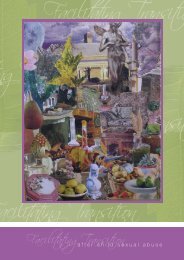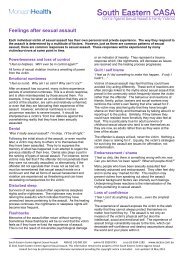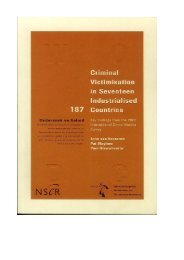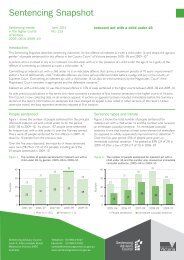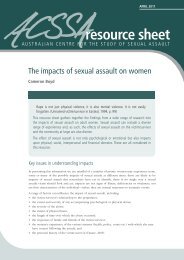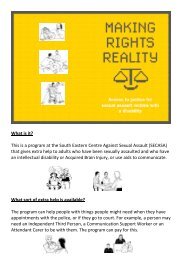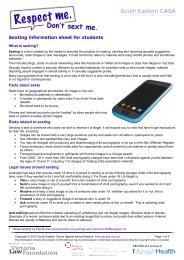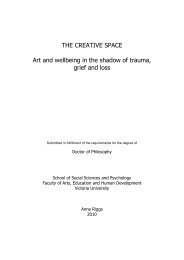Sex In Australia Summary - Health and health care for lesbian ...
Sex In Australia Summary - Health and health care for lesbian ...
Sex In Australia Summary - Health and health care for lesbian ...
Create successful ePaper yourself
Turn your PDF publications into a flip-book with our unique Google optimized e-Paper software.
<strong>Sex</strong> in <strong>Australia</strong><br />
<strong>Summary</strong> findings of the <strong>Australia</strong>n Study of <strong>Health</strong> <strong>and</strong> Relationships<br />
ABOUT THE STUDY<br />
The <strong>Australia</strong>n Study of <strong>Health</strong> <strong>and</strong> Relationships is the largest <strong>and</strong> most<br />
comprehensive survey of sexuality ever undertaken in this country.<br />
It was a representative population-based survey of the sexual <strong>health</strong> behaviours,<br />
attitudes <strong>and</strong> knowledge of <strong>Australia</strong>n people. Telephone interviews were conducted<br />
with 19,307 respondents between the ages of 16 <strong>and</strong> 59 years in 2001/2002.<br />
The sample consisted of 10,173 men <strong>and</strong> 9,134 women r<strong>and</strong>omly selected from all<br />
states <strong>and</strong> territories of <strong>Australia</strong>. The response rate was 73.1% which compares<br />
favorably with other population based national samples. Most respondents indicated<br />
that they were entirely honest in their responses <strong>and</strong> not embarrassed by the questions<br />
asked. The sample was weighted to reflect the location, age <strong>and</strong> sex distribution of<br />
the 2001 census. The sample is there<strong>for</strong>e regarded as being broadly representative<br />
of the <strong>Australia</strong>n population.<br />
The content <strong>and</strong> method of the survey was in<strong>for</strong>med by the experience of other largescale<br />
national surveys conducted in the United States of America, the United<br />
Kingdom <strong>and</strong> France.<br />
THE RESULTS<br />
<strong>Sex</strong>ual experience<br />
The onset of sexual activity was examined with respect to the decade in which<br />
people were born. Half the men born between 1941 <strong>and</strong> 1950 had vaginal<br />
intercourse by age 18 <strong>and</strong> this declined to 16 <strong>for</strong> men born between 1981 <strong>and</strong><br />
1986. For women the age at first vaginal intercourse declined from 19 to 16.<br />
Contraceptive use at first intercourse increased from less than 30% of men <strong>and</strong><br />
women in the 1950s to over 90% in the 2000s. The age at first experience of<br />
oral sex declined even more steeply over that period <strong>and</strong> now typically occurs<br />
around the time of first vaginal intercourse rather than some years afterward.<br />
The age of first homosexual experience was higher than the age of first<br />
heterosexual experience. Thus, the majority of young people in the final years<br />
of school today will have commenced sexual activity, <strong>and</strong> this highlights the<br />
importance of sex education in schools.<br />
Heterosexual men reported more partners over their lifetime, in the last five years<br />
<strong>and</strong> in the last year than did heterosexual women, with 15.1% of heterosexual men<br />
<strong>and</strong> 8.5% of heterosexual women reporting multiple sexual partners in the last year,<br />
although these partnerships were not necessarily concurrent. People who identified<br />
as homosexual or bisexual reported more partners than did those who identified<br />
as heterosexual. Homosexual men <strong>and</strong> bisexual men <strong>and</strong> women had had more<br />
partners than had <strong>lesbian</strong>s.<br />
One person in four had not had sex in the previous four weeks <strong>and</strong> most people in<br />
the survey, both men <strong>and</strong> women, wanted more sex than they were having. Most<br />
people had sex less than twice a week, whereas 23.4% of men <strong>and</strong> 8.3% of<br />
women would like to have had sex daily or more often. Those who had been in<br />
heterosexual relationships <strong>for</strong> at least twelve months had sex on average 1.84 times<br />
a week in the past four weeks, with younger people having sex more frequently.<br />
<strong>Australia</strong>n Research Centre<br />
in <strong>Sex</strong>, <strong>Health</strong> & Society,<br />
La Trobe University<br />
Central Sydney Area<br />
<strong>Health</strong> Service<br />
National Centre in HIV<br />
Social Research,<br />
the University of NSW<br />
National Centre in HIV<br />
Epidemiology <strong>and</strong> Clinical<br />
Research, the University of NSW<br />
ORDERING<br />
THE FULL<br />
REPORT<br />
Copies of the full report are<br />
available from ARCSHS at<br />
the cost of A$30 <strong>for</strong><br />
<strong>Australia</strong>n <strong>and</strong><br />
New Zeal<strong>and</strong> orders, <strong>and</strong><br />
US$30 elsewhere (costs<br />
include postage <strong>and</strong> GST).<br />
Send cheque payable<br />
to ‘ARCSHS’ to:<br />
SEX IN AUSTRALIA<br />
<strong>Australia</strong>n Research<br />
Centre in <strong>Sex</strong>, <strong>Health</strong><br />
<strong>and</strong> Society,<br />
La Trobe University<br />
Level 1, 215 Franklin St,<br />
Melbourne 3000<br />
<strong>Australia</strong><br />
Telephone<br />
+61 3 9285 5382<br />
Fax<br />
+61 3 9285 5220<br />
Email<br />
arcshs@latrobe.edu.au<br />
Website<br />
www.latrobe.edu.au/arcshs
Relationships<br />
By far the majority of those surveyed (85.3% of men <strong>and</strong><br />
89.5% of women) were in a regular heterosexual<br />
relationship. The majority of those in heterosexual<br />
relationships expected neither themselves nor their partner to<br />
have sex outside the relationship although women were more<br />
likely to have discussed this expectation with their partners<br />
than were men. Only 4.9% of men <strong>and</strong> 2.9% of women in<br />
regular relationships had concurrent sexual partners in the last<br />
twelve months.<br />
Most people in heterosexual relationships found sex very or<br />
extremely pleasurable (90.3% men <strong>and</strong> 79.1% women) with<br />
high levels of emotional satisfaction also reported (87.5%<br />
men <strong>and</strong> 79.1% women). Physical pleasure in sex was<br />
strongly related to emotional satisfaction.<br />
Attitudes<br />
Over three quarters of men <strong>and</strong> women agreed that<br />
premarital sex is acceptable. There was little difference<br />
between men <strong>and</strong> women. Three quarters of respondents<br />
agreed that oral sex is sex, again with no gender<br />
differences, <strong>and</strong> three quarters also agreed that having an<br />
affair outside a committed relationship is wrong. The majority<br />
agreed that having sex is important to well-being.<br />
Men were less tolerant of male homosexual behaviour than of<br />
female homosexual behaviour. Similarly, women were less<br />
tolerant of female homosexual behaviour than of male<br />
homosexual behavior. Women were, however, generally more<br />
tolerant of homosexual behaviour overall than were men.<br />
<strong>Sex</strong>ual identity, attraction<br />
<strong>and</strong> experience<br />
<strong>In</strong> presenting the results of the survey the terms ‘<strong>lesbian</strong>’, ‘gay’<br />
<strong>and</strong> ‘bisexual’ are used to describe only those people who<br />
identify by these terms <strong>and</strong> not those who are attracted to<br />
others of the same sex or who have had sexual experience<br />
with others of the same sex but do not themselves identify<br />
with these terms.<br />
<strong>In</strong> this study 97.4% of men identified as heterosexual, 1.6%<br />
as gay <strong>and</strong> 0.9% as bisexual. For women 97.7% identified<br />
as heterosexual, 0.8% as gay <strong>and</strong> 1.4% as bisexual.<br />
Nevertheless, 8.6% of men <strong>and</strong> 15.1% of women reported<br />
either feelings of attraction to the same sex or some sexual<br />
experience with the same sex. Half the men <strong>and</strong> two thirds of<br />
the women who had same sex sexual experience regarded<br />
themselves as heterosexual rather than homosexual. This<br />
illustrates that same sex attraction <strong>and</strong> experience are more<br />
common in <strong>Australia</strong> that is indicated by the relatively few<br />
people reporting a homosexual or bisexual identity.<br />
<strong>Sex</strong> in<br />
Safer sex <strong>and</strong> condom use<br />
Among those who reported casual partners, unprotected sex<br />
was more common in heterosexual activity than in male<br />
homosexual activity. Of heterosexually active people, 3.3%<br />
reported unprotected sex with casual partners. This represents<br />
59% of the heterosexuals who had casual partners. Among<br />
homosexually active males 2.1% reported unprotected anal<br />
sex with casual partners (12% of those with such partners)<br />
Condoms were used in 20% of the most recent episodes of<br />
vaginal intercourse. Their rate of use generally was associated<br />
with partner type <strong>and</strong> use of other contraception, suggesting<br />
that they are largely used <strong>for</strong> contraceptive purposes. <strong>In</strong> the<br />
previous six months few people (7.1%) always used condoms<br />
with a regular live-in partner, more (22.5%) with a regular<br />
partner who did not live with them, <strong>and</strong> more again (41.4%)<br />
always used condoms with casual partners .<br />
Condom breakage was experienced by 23.8% of the men<br />
in the sample <strong>and</strong> condom slippage by 18.1%. Condom<br />
breakage appears to be associated with how experienced<br />
the user is, rather than the quality of condoms <strong>and</strong> lubricant.<br />
Contraception <strong>and</strong> pregnancy<br />
Of those at risk <strong>for</strong> pregnancy, 95% were using some <strong>for</strong>m of<br />
contraception. Oral contraception (33.6%) was the most<br />
popular with tubal ligation/hysterectomy (22.5%), condoms<br />
(21.4%) <strong>and</strong> vasectomy (19.3%) also widely used. Tubal<br />
ligation was more common in regional <strong>and</strong> remote areas<br />
<strong>and</strong> condom use less common. Of those who had vaginal<br />
intercourse 19.2% had used emergency contraception, of<br />
them 53.3% only once.<br />
Reasons <strong>for</strong> not using contraception included side-effects (23%),<br />
leaving it to chance (20.2%), <strong>for</strong>getting or not caring (18.9%),<br />
breast feeding (16.5%) <strong>and</strong> believing it unnatural or un<strong>health</strong>y<br />
(13.7%). No women cited religious objections or lack of<br />
access to services as a reason <strong>for</strong> not using contraception.<br />
Although 15.5% of the women surveyed reported having<br />
experienced some difficulty becoming pregnant, 76.1% had<br />
been pregnant at least once <strong>and</strong> nearly all of these had<br />
experienced a live birth. Of women who had been pregnant<br />
miscarriage had been experienced by 33.4% of women <strong>and</strong><br />
termination by 22.6%.<br />
There has been a decline in the proportion of women<br />
becoming pregnant <strong>for</strong> the first time as teenagers. Among<br />
women aged 50-59, 22.8% first became pregnant as<br />
teenagers, compared to 16.9% in women aged 20 – 29<br />
years. The may be in part explained by increasing<br />
contraceptive use. Contraception was used in the first<br />
episode of vaginal intercourse by less than 30% of those<br />
making their sexual debut in the 1950s as opposed to more<br />
than 90% having sex <strong>for</strong> the first time in the 2000s.
<strong>Australia</strong><br />
Knowledge about sexually<br />
transmissible infections<br />
<strong>Australia</strong>ns generally have poor knowledge about the<br />
transmission <strong>and</strong> <strong>health</strong> consequences of sexually transmitted<br />
infections, with women knowing more than men. Respondents<br />
knew relatively little about genital herpes, gonorrhoea,<br />
genital warts <strong>and</strong> chlamydia, some of which are common<br />
amongst sexually active people in <strong>Australia</strong>.<br />
<strong>Sex</strong>ually transmissible<br />
infections <strong>and</strong> blood-borne<br />
viruses<br />
Overall, 20.2% of men <strong>and</strong> 16.9% of women had ever<br />
been diagnosed with a sexually transmissible infection or<br />
blood-borne virus, <strong>and</strong> 2.0% <strong>and</strong> 2.2% respectively had<br />
been diagnosed in the last year. The most commonly<br />
diagnosed sexually transmissible infection among women<br />
was c<strong>and</strong>idiasis or thrush (31.9% of respondents). The next<br />
most common sexually transmissible infections among men<br />
<strong>and</strong> women were pubic lice or crabs (7.1%), genital warts<br />
(4.2%), chlamydia (2.4%), herpes (2.3%) <strong>and</strong> gonorrhoea<br />
(1.4%). Overall, 1.8% of respondents had been diagnosed<br />
with hepatitis A, 0.7% had been diagnosed with hepatitis B,<br />
<strong>and</strong> 0.5% had been diagnosed with hepatitis C. The<br />
respondent’s usual general practitioner was the most common<br />
location of treatment.<br />
<strong>Sex</strong>ual difficulties<br />
Survey participants reported a range of sexual difficulties that<br />
they had experienced <strong>for</strong> at least one month in the previous<br />
year. The most common were lack of interest in sex (24.9%<br />
of men <strong>and</strong> 54.8% of women), coming to orgasm too<br />
quickly (23.8% of men <strong>and</strong> 11.7% of women), not having an<br />
orgasm (6.3% of men <strong>and</strong> 28.6% of women) <strong>and</strong> not<br />
enjoying sex (5.6% of men <strong>and</strong> 27.3% of women). Physical<br />
pain (2.4% of men <strong>and</strong> 20.3% of women) <strong>and</strong> worry about<br />
body image (14.2% of men <strong>and</strong> 35.9 % of women) were<br />
also reported.<br />
Masturbation <strong>and</strong> other<br />
non-coital practices<br />
<strong>In</strong> the past year 65% of men <strong>and</strong> 35% of women had<br />
masturbated, half of the men <strong>and</strong> a quarter of the women in<br />
the past four weeks, with men masturbating more frequently<br />
than women.<br />
A quarter of all respondents had watched X rated videos<br />
(37% men <strong>and</strong> 16% women) <strong>and</strong> a smaller number had<br />
visited an internet sex site (17% men <strong>and</strong> 12% women). <strong>Sex</strong><br />
toys were used by 14% of women <strong>and</strong> 12% men.<br />
Digital anal stimulation with a partner had been engaged in<br />
by 17% men <strong>and</strong> 14% women. Other practices such as<br />
phone sex, role-play, sadomasochism, bondage <strong>and</strong><br />
discipline, fisting <strong>and</strong> rimming were engaged in by less than<br />
5% of the population.<br />
Commercial sex<br />
One in six <strong>Australia</strong>n men (15.6%) have paid <strong>for</strong> sex at some<br />
time in their life (97% with women) <strong>and</strong> 1.9% in the past<br />
year. Only 0.1% of women have ever paid <strong>for</strong> sex. Twice as<br />
many men (0.9%) as women (0.5%) had ever been paid <strong>for</strong><br />
sex. Condoms were more likely to be used <strong>for</strong> commercial<br />
sex in brothels <strong>and</strong> parlours than with street-based sex<br />
workers.<br />
<strong>Sex</strong>ual coercion<br />
A small proportion of men (4.8%) <strong>and</strong> a much larger<br />
proportion of women (21.1%) had been <strong>for</strong>ced or frightened<br />
into unwanted sexual activity, many of them (2.8% men <strong>and</strong><br />
10.3% women) when they were 16 years of age or under.<br />
The experience of sexual coercion <strong>for</strong> both men <strong>and</strong> women<br />
was associated with higher levels of psychosocial distress,<br />
smoking, anxiety about sex <strong>and</strong> having had a sexually<br />
transmitted infection. Few people who had been coerced<br />
had talked about their experience to others <strong>and</strong> even fewer<br />
to a counselor, highlighting the need <strong>for</strong> more widely<br />
promoted <strong>and</strong> accessible services.<br />
<strong>In</strong>jecting drug use risks<br />
A history of injecting drugs was reported by 3% of the<br />
sample with men being more likely to do so than women<br />
(1.8%). Of those who had injected, 12.4% had shared<br />
needles <strong>and</strong> 43% had shared other paraphernalia. This is<br />
evidence of a significant minority of people at risk of bloodborne<br />
viruses through this means.
POLICY<br />
IMPLICATIONS<br />
The age of sexual intercourse has been declining <strong>for</strong> at least<br />
the last fifty years. Coupled with an increasing age at<br />
marriage or entry into some other long-term relationship, this<br />
means that there is a large segment of the <strong>Australia</strong> population<br />
engaging in either concurrent relationships or serial<br />
monogamy. Having multiple partners <strong>and</strong> not always using<br />
condoms are a partial explanation <strong>for</strong> why sexually<br />
transmissible infections <strong>and</strong> blood-borne viruses appear<br />
relatively common in the <strong>Australia</strong>n population. Un<strong>for</strong>tunately,<br />
knowledge of the transmission routes <strong>and</strong> <strong>health</strong> consequences<br />
of the most common sexually transmissible infections was poor.<br />
Most people with sexually transmissible infections present to<br />
their general practitioner. This underlines the importance of<br />
ensuring that general practitioners are appropriately trained<br />
<strong>and</strong> resourced to effectively diagnose <strong>and</strong> treat sexually<br />
transmissible infections. This also means that education about<br />
safe sex is not something that should be specifically directed<br />
only at young people but may need to be refocused to<br />
address the needs of people throughout their twenties, thirties,<br />
<strong>for</strong>ties <strong>and</strong> beyond. The declining age at first intercourse,<br />
given that other <strong>for</strong>ms of sexual activity commonly occur<br />
be<strong>for</strong>e the first experience of intercourse, highlights the need<br />
to urgently review the teaching of sexuality education in<br />
primary school.<br />
We found that the proportion of people who identify as gay,<br />
<strong>lesbian</strong> or bisexual is relatively small, but the proportion<br />
reporting some homosexual experience is considerable<br />
greater. Given that the overwhelming majority of <strong>health</strong><br />
education <strong>and</strong> <strong>health</strong> promotion is focused on heterosexuals,<br />
the appropriate representation of <strong>lesbian</strong>, gay <strong>and</strong> bisexual<br />
people in those activities is long overdue. The additional<br />
complexity presented by people who have same sex<br />
experience <strong>and</strong> identify as heterosexual needs also to be<br />
addressed where appropriate.<br />
We found evidence that most women at risk <strong>for</strong> pregnancy<br />
were using some <strong>for</strong>m of contraception, most of them<br />
generally reliable. Most women surveyed had been pregnant<br />
at least once. Of concern, some 17% of pregnancies<br />
enumerated by women in this sample ended in miscarriage<br />
<strong>and</strong> one in three <strong>Australia</strong>n women report having experienced<br />
a miscarriage at least once. While we are unable shed light<br />
on the causes of those events, their prevalence certainly<br />
suggests there is a need <strong>for</strong> further research on the issue.<br />
The overwhelming majority of people in relationships found<br />
them to be emotionally satisfying <strong>and</strong> physically pleasurable.<br />
However, we found that a large proportion of <strong>Australia</strong>ns<br />
experience some <strong>for</strong>m of sexual difficulty. We did not<br />
measure sexual dysfunction <strong>and</strong> we would strongly caution<br />
against any attempt to read our data in that way. However,<br />
the prevalence of the problems identified highlights the need<br />
<strong>for</strong> further research in this area.<br />
Generally, <strong>Australia</strong>ns do not hold particularly conservative<br />
attitudes towards sexuality. A substantial minority of <strong>Australia</strong>ns<br />
watch X-rated films, use sex toys, intentionally visit internet sex<br />
sites <strong>and</strong>, among men, have paid <strong>for</strong> sex at least once during<br />
their life.<br />
Finally, one in five <strong>Australia</strong>n women <strong>and</strong> one in 20<br />
<strong>Australia</strong>n men reported having experienced sexual coercion<br />
at some time in their life. Approximately half of these women<br />
<strong>and</strong> men reported that they experienced sexual coercion<br />
when aged 16 years or younger. Few people who had<br />
experienced coercion had talked to others about their<br />
experiences of sexual coercion <strong>and</strong> even fewer had talked to<br />
a professional. This un<strong>for</strong>tunate silence may seem at odds<br />
with the extensive public discourse about sexual coercion. It is<br />
unclear whether the lack of service use <strong>for</strong> issues concerning<br />
sexual coercion is related to a perceived lack of appropriate<br />
services or other factors.<br />
THE FULL REPORT<br />
The primary report of the <strong>Australia</strong>n Study of <strong>Health</strong> <strong>and</strong><br />
Relationships is published as the <strong>Australia</strong>n <strong>and</strong> New Zeal<strong>and</strong><br />
Journal of Public <strong>Health</strong>, Volume 27, Number 2, April 2003.<br />
ABOUT THE AUTHORS<br />
Dr Anthony Smith is Associate Professor, Principal Research<br />
Fellow <strong>and</strong> Vic<strong>Health</strong> Senior Research Fellow at the <strong>Australia</strong>n<br />
Research Centre in <strong>Sex</strong>, <strong>Health</strong> <strong>and</strong> Society. Dr Chris Rissel is<br />
Director of the <strong>Health</strong> Promotion Unit of Central Sydney Area<br />
<strong>Health</strong> Service <strong>and</strong> a Clinical Senior Lecturer in Public <strong>Health</strong><br />
in the <strong>Australia</strong>n Centre <strong>for</strong> <strong>Health</strong> Promotion at the University<br />
of Sydney. Dr Juliet Richters is a Senior Research Fellow at the<br />
National Centre in HIV Social Research at the University of<br />
New South Wales. Dr Andrew Grulich is an Associate<br />
Professor <strong>and</strong> Head of the HIV Epidemiology <strong>and</strong> Prevention<br />
Program at the National Centre in HIV Epidemiology <strong>and</strong><br />
Clinical Research at the University of New South Wales.<br />
Dr Richard de Visser is a National <strong>Health</strong> <strong>and</strong> Medical<br />
Research Council Sidney Sax Fellow in the Centre <strong>for</strong><br />
Psychosocial Studies, Birkbeck, University of London.<br />
ACKNOWLEDGEMENTS<br />
The <strong>Australia</strong>n Study of <strong>Health</strong> <strong>and</strong> Relationships study was made possible through<br />
funding from the Commonwealth Department of <strong>Health</strong> <strong>and</strong> Ageing, the Victorian<br />
<strong>Health</strong> Promotion Foundation, the <strong>health</strong> departments of New South Wales,<br />
Queensl<strong>and</strong> <strong>and</strong> Western <strong>Australia</strong>, <strong>and</strong> the Central Sydney Area <strong>Health</strong> Service.<br />
Our work was supported by the <strong>Australia</strong>n Research Centre in <strong>Sex</strong>, <strong>Health</strong> <strong>and</strong><br />
Society (La Trobe University), Central Sydney Area <strong>Health</strong> Service <strong>and</strong> the<br />
<strong>Australia</strong>n Centre <strong>for</strong> <strong>Health</strong> Promotion (University of Sydney), the National Centre<br />
in HIV Social Research (University of New South Wales) <strong>and</strong> the National Centre<br />
in HIV Epidemiology <strong>and</strong> Clinical Research (University of New South Wales).<br />
Jeanette Ward, S<strong>and</strong>y Gif<strong>for</strong>d, Aileen Plant, Louisa Jorm <strong>and</strong> Elizabeth Proude<br />
were of particular assistance in the early stages of the study. The advice of the<br />
study’s Advisory Committee of John Kaldor, Sue Kippax, Judy Simpson <strong>and</strong> Louisa<br />
Jorm is gratefully acknowledged as is the input of the representatives of<br />
Commonwealth Department of <strong>Health</strong> <strong>and</strong> Ageing who were members of the<br />
Advisory Committee over the life of the study: Paul Lehmann; Roger Nixon; <strong>and</strong>,<br />
Debra Gradie. We also wish to thank the many other colleagues who offered<br />
advice on the content of questionnaire, particularly June Craw<strong>for</strong>d, Basil Donovan,<br />
John Gagnon <strong>and</strong> norrie mAy-welby. We are indebted to the staff of the Hunter<br />
Valley Research Foundation who managed the data collection <strong>and</strong> undertook the<br />
interviewing <strong>for</strong> this study.



